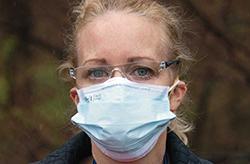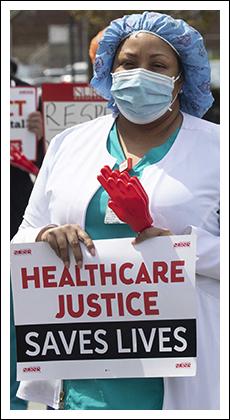How to Move New York Forward: What Frontline Nurses Need Before New York Reopens

Nurses have been on frontlines in this crisis. We’ve seen firsthand just how deadly COVID-19 can be.
Despite our repeated warnings, public health officials and elected leaders were unprepared for this pandemic. We can never let that happen again.
Here are some of the things New York must to do to move forward and reopen. Anything less means we’re likely sacrificing thousands more New Yorkers to this deadly disease.
Fortifying the Frontlines

Science Sets the Standard: We are only beginning to understand SARS-CoV-2, but we know that we cannot go back to the way our hospitals operated before. We must establish a new normal — where safety, not efficiency or expediency, drive decision making. The continuing risk of airborne and contract transmission require COVID-19 standard precautions, including respiratory protection for any staff member coming in contact with the public, along with masks and strict screening measures for incoming patients, family members, or anyone else coming in the building.
Enhanced PPE: Every hospital in the state must adopt enhanced conventional capacity guidelines and begin the migration to reusable equipment, including fit-testing for all respirators. Stockpiles must be built up, so healthcare workers aren’t left unprotected during the next outbreak. Essential workers must also be protected, it’s not enough for healthcare workers to get PPE if there is rationing for transit workers, grocery clerks, factory workers, or delivery drivers.
Universal Testing: Lack of protections have turned nurses, along with other essential workers, into a transmission vector for this virus. We need on-demand rapid-result diagnostic testing for all frontline workers. All incoming patients and hospital visitors should also be tested. Once accurate antibody tests are widely available they may be useful for epidemiological purposes, but antibody tests cannot be used to send workers back to work, or worse, to ration their PPE.
Time to Rest and Recover: Nurses have been fighting this virus with everything we’ve got and many have fallen ill. Healthcare workers, whether symptomatic or COVID-positive, must be provided the internationally recognized two-week quarantine or isolation period. We must also be able to access the paid sick time benefits available to all New Yorkers, and more if required. Regular hospital schedules must be restored, including extra paid time off for those who’ve been on the frontlines.
Ongoing Accommodations: At-risk healthcare workers must receive the protections they need to safely provide patient care, or be provided alternative assignments. We must continue to provide housing and other supports required to protect at-risk family members.
Transparency and the Right to Know: Nurses and other healthcare workers have a right to know what risks they’re facing when they report to work. Hospitals must be transparent with workers and the public, reporting essential information such as how many COVID-positive patients they are treating, levels of PPE inventory, ongoing plans for screening and cohorting, and the number of staff who’ve been exposed to or gotten sick from COVID-19.
Restoring Elective Procedures Responsibly: Hospitals are chomping at the bit to restart lucrative elective procedures. But generating revenue cannot come at the expense of the health and safety of frontline healthcare workers. Elective procedures must be phased in only as the COVID-19 census falls, and suspended automatically if it starts to rise. We must ensure all patients are tested 24 hours prior to admission and that COVID-specific standard precautions are instituted for operating rooms and labor and delivery. The state should also ensure hard-hit safety net hospitals are not further financially disadvantaged, as they will be among the last to be able to restore elective procedures.
Safe Staffing Across the State: Hospitals cut staffing to the bone before COVID-19 and our patients paid the price when the pandemic hit. Going forward, we need far more staff to protect our patients, and we need the same staffing standard in every hospital. With over 19,000 fatalities statewide, and an imminent risk of outbreak in every community, no hospital can justify layoffs or other reductions in the healthcare workforce.
Maintain Surge Capacity: New York will see another wave of COVID-19 and we need to be prepared. While many facilities will need to lower their current bed capacity in order to restore suspended services, we can maintain surge capacity with a moratorium on hospital closings and the reactivation of shuttered units. New York must maintain enough hospital beds and adequately trained staff for repeated outbreaks — this is not a one-time event.
Build Back Better: This crisis has revealed significant shortcomings with our healthcare infrastructure. We need major improvements to hospital plant and equipment, including HVAC upgrades to improve ventilation, along with other engineering controls that are supposed to be our first line of defense against workplace hazards. The state must provide full funding, particularly for the safety net hospitals hardest hit by the pandemic.
Coordinated Purchasing Pools: The governor has repeatedly claimed we’re operating as “one system” throughout this crisis, but hospitals have been in a needless bidding war for PPE and other critical supplies. The state must take a central role in coordinating purchase and distribution of PPE, to ensure supplies are delivered where they are most needed, not to the hospital with the most resources.
Centering Our Response on Hardest Hit Communities
COVID-19 has laid bare the deep economic and racial disparities in our state’s healthcare system. We cannot move New York forward without recognizing and beginning to rectify them.
Addressing Racial Disparities: African Americans and Latinos are dying from COVID-19 at twice the rate of white New Yorkers. Reversing these longstanding inequalities must be a central focus as we move forward, and state lawmakers must prioritize funding for significant new healthcare infrastructure in hardest hit communities.
Fixing Healthcare Funding: We can’t protect patients by slashing healthcare funding. We must restore the $2.5 billion in Medicaid cuts in next year’s state budget, and finally fix our Medicaid funding formulas to allocate resources based on need. Safety net hospitals have borne the brunt of the COVID crisis, and they should receive a disproportionate share of state Medicaid funding. These hospitals must also receive extra assistance, given that they will be among the last facilities to re-open elective procedures.
Real Accountability for the Public’s Health: For too long hospital administrators and elected officials have sidestepped responsibility for addressing the urgent health needs in our communities. We cannot return to a healthcare system where your zip code determines your life expectancy. What we do in New York’s historically underserved communities will be the yardstick by which we measure our progress.
Safeguarding Every New Yorker
Our first priority must be the public’s health, and New York can’t move forward until we can protect every New Yorker.
Everyone In, Nobody Out: With over a million New Yorkers out of work we need to make sure they can get the care they need during this pandemic. The New York Health Act would provide universal healthcare for everyone in the state, and lawmakers must take the first steps in that direction by paying for all COVID-related healthcare costs for unemployed, uninsured, underinsured, or undocumented New Yorkers.
Protecting Public Health with Testing and Tracing: New York cannot reopen until we’ve got the tools we need to stop another outbreak. This requires widespread COVID-19 testing — far beyond our current goal of 40,000 tests per day — so we can identify and isolate infected residents. We also need thousands of contact tracers working for the state to uncover exposures and avoid runaway infection.
No State Budget Cuts to Vital Services: There is no precedent for the economic and social impact of this pandemic. New York must provide enhanced unemployment insurance, expanded health care coverage, even food and shelter for New Yorkers in need. And the federal government must unlock whatever resources are needed to maintain vital programs and offset the economic dislocations from COVID-19. Austerity is not an option. If federal response is inadequate, the state must raise the necessary revenue, starting with Wall Street and big corporations. New York’s billionaires and millionaires must also pay their fair share.
While we’re relieved to see hospitalizations declining in many parts of the state, this does not mean the COVID-19 crisis is over or that it is safe to reopen.
There is no vaccine, and we don’t know if or when one will be widely available. The virus hasn’t become less contagious or less deadly while New York has been “on pause.”
Once we lift emergency measures and people begin to return to work or gather in public there will be more outbreaks. We can also expect a second or even third wave coinciding with flu season. It’s not a question of whether, but when.
In January, as we witnessed the deadly progression of COVID-19 around the world, we sounded the alarm to New York’s hospitals. Then, in early March, our leaders spoke at a news conference, citing government inaction in matters of the public’s health — in particular the Trump administration’s denials and delays, resulting in the loss of tens of thousands of lives.
And for the last two months nurses and other healthcare workers have borne witness to this preventable tragedy.
That is something we cannot — we will not — allow.